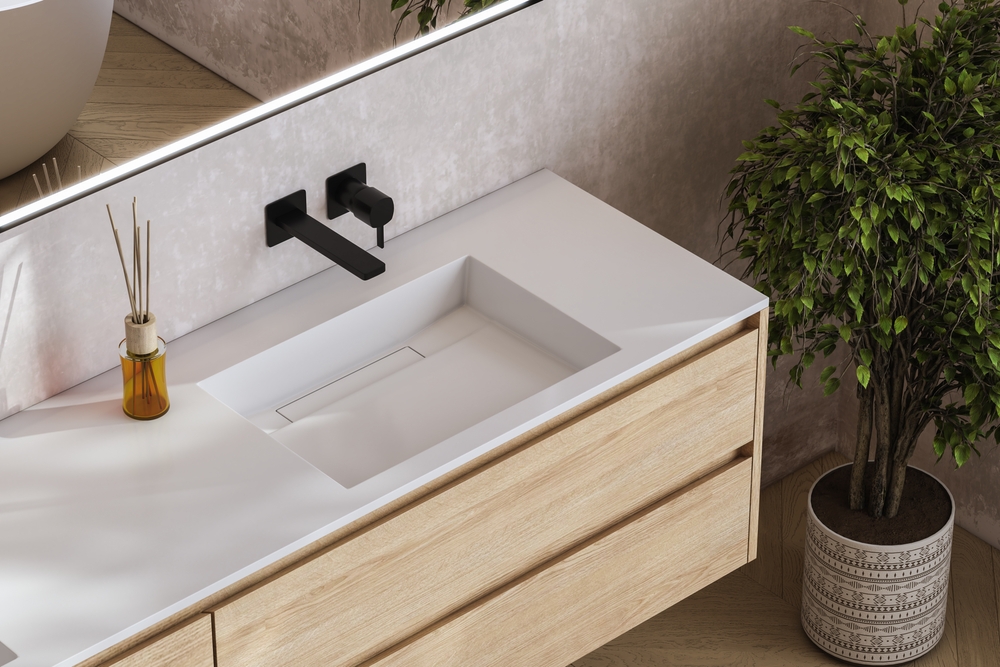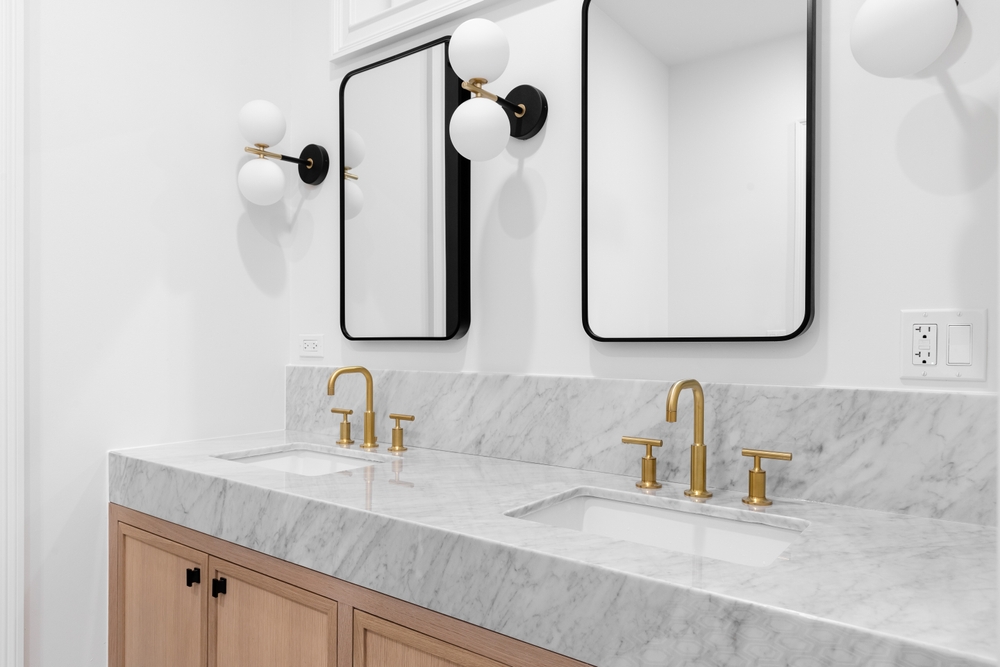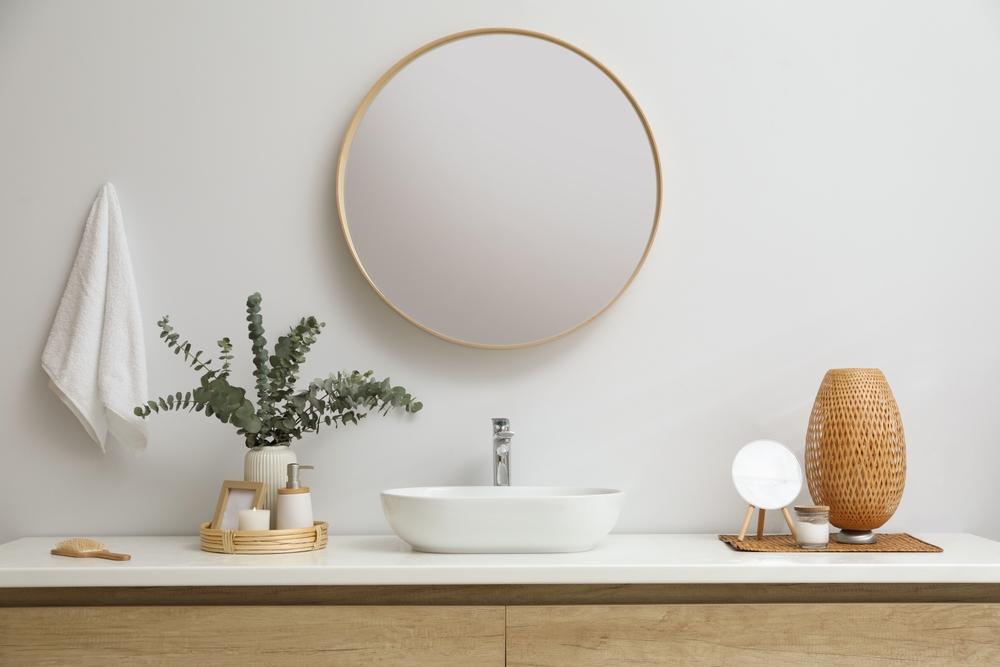What Are Bathroom Countertops Made Of ?

When it comes to home design and renovation, bathrooms often take center stage as spaces for both functionality and style. Among the many elements that contribute to a bathroom’s aesthetic and practicality, countertops play a vital role.
These surfaces not only provide a workspace for daily grooming routines but also set the tone for the entire room’s decor. Choosing countertop material is crucial in bathroom design, balancing durability, aesthetics, and cost. But what are bathroom countertops made of?
From classic options that have stood the test of time to innovative materials pushing the boundaries of design, the world of bathroom countertops offers a diverse array of possibilities. Each material brings its own unique set of characteristics, advantages, and challenges, catering to different needs, preferences, and budgets.
In this exploration of bathroom countertop materials, we’ll dive into the various options available, helping you navigate the choices for your next bathroom upgrade or renovation.

What Are Bathroom Countertops Made Of?
Granite countertops
Composition of granite countertops
Granite is a natural stone composed primarily of quartz, feldspar, and mica. Quarried from the Earth, it’s cut into slabs, processed, and polished for use as countertops.
Each piece of granite has a unique pattern and color due to its natural formation. The stone’s durability and aesthetic appeal make it a popular choice for bathroom surfaces and it will match with the bathroom vanity color depending on your color choice.
Durability and heat resistance
Granite’s extreme durability makes it ideal for high-traffic bathrooms, resisting scratches and chips effectively. Its heat resistance allows it to withstand hot styling tools without damage. When properly sealed, granite also resists stains, water, and bathroom chemicals, enhancing its practicality for bathroom use.
Popularity in bathrooms
Granite’s natural beauty, with its unique patterns, adds character to bathroom decor. Its durability ensures a long-lasting appearance, often justifying the higher initial cost. As a premium material, granite also enhances home value, benefiting potential future sales.
Marble countertops
Composition of marble countertops
Marble, a metamorphic rock, is formed when limestone is subjected to intense heat and pressure, resulting in its distinctive veining. Composed primarily of calcite, the presence of other minerals can influence its color, adding to its natural beauty.
Quarried and cut into slabs for countertops, marble shares a unique characteristic with granite – no two pieces are exactly alike. Each slab boasts its one-of-a-kind veining patterns, making every piece of marble truly unique.
Elegant appearance and veining
Marble is known for its luxurious look and smooth, cool surface that feels elegant to the touch. Its classic beauty has been cherished for centuries. The distinctive veining of marble adds visual interest, ranging from subtle to dramatic, making it a focal point in bathroom design.
Marble comes in various colors. White and light gray are popular choices, making a bathroom feel more spacious.
Maintenance considerations
Marble requires more care than some other materials. It’s also softer and more porous than granite, making it more susceptible to scratches and stains. Regular sealing is necessary to protect marble and prevent staining from water and toiletries.
Acidic substances can etch marble’s surface. Care must be taken with bathroom cleaning products, and spills should be wiped up promptly to prevent damage.
Quartz countertops
Composition of quartz countertops
Quartz countertops are engineered stone made from ground natural quartz combined with resins and pigments. The mixture typically contains 90-95% ground quartz, with the remaining percentage consisting of binding agents and colors, creating a very hard and durable material. Unlike natural stone, quartz countertops are manufactured, allowing for more consistent colors and patterns.

Non-porous nature and stain resistance
Quartz’s non-porous structure resists liquid absorption, preventing stains from water, soap, and cosmetics. It requires no sealing, making it low maintenance. Resistant to bacteria, mold, and most cleaning products, quartz remains easy to clean and hygienic. Unlike marble, it won’t etch, enhancing its durability in bathroom settings.
Color and pattern variety
Quartz countertops offer a wide range of colors, mimicking natural stone or providing solid hues and unique patterns. Their manufactured nature ensures consistent appearance. This is advantageous for large bathrooms requiring uniform looks across multiple sections.
Some quartz options include sparkles or glass pieces, adding visual interest and allowing for customized designs.
Solid surface countertops
Composition of solid surface countertops
Solid surface countertops are man-made materials composed of acrylic or polyester resins combined with minerals and pigments. This mixture is molded into sheets, then fabricated into seamless, non-porous countertops. Developed as an alternative to natural stone, solid surfaces offer comparable durability with enhanced design flexibility.
Seamless appearance and repairability
One key advantage of a solid surface is its seamless look. Joints are fused together during installation, creating a smooth, continuous surface. Minor scratches and damage can often be buffed out, while deeper damage can be repaired by professionals, making the countertop look new again. The non-porous nature resists stains and bacteria growth, making it a hygienic choice for bathrooms.
Customization and maintenance
Solid surface countertops offer extensive customization options, coming in a wide range of colors and patterns. Custom colors can be created for solid surface materials, allowing for integrated sinks that give a sleek, modern look—an advantage that simplifies the choice when selecting bathroom cabinets. The seam between the sink and countertop is eliminated.
Maintenance is relatively simple; regular cleaning with mild soap is usually sufficient, and no sealing is required to maintain its appearance and performance.
Laminate countertops
Composition of laminate countertops
Laminate countertops consist of layers of paper and resin fused together under high pressure and heat, with a decorative layer added on top. The core is typically made of particleboard or MDF, providing structure and support. The top layer can mimic the look of other materials. As a manufactured product, laminate allows for a wide range of colors and patterns.
Affordability and design options
Laminate is one of the most affordable countertop options, making it popular for budget-conscious renovations. It’s also easy to install, which helps reduce labor costs.
Available in countless colors and patterns, laminate can even mimic the appearance of stone or wood.
Thanks to modern printing techniques, the visuals are impressively realistic. Additionally, new edge options, such as beveled and wrapped edges, have enhanced lamiante’s aesthetic appeal, allowing it to compete with more expensive materials.
Durability considerations
Laminate is less durable than stone or quartz and can scratch or chip more easily, making replacement and repairement often difficult or impossible. The material is not heat-resistant, so hot styling tools can damage the surface, necessitating the use of trivets or heat-resistant mats.
Water can damage laminate if it penetrates the seams, so proper installation and sealing of edges are crucial to prevent water infiltration and swelling.
Tile countertops
Composition of tile countertops
Tile countertops bring a touch of artistry to your bathroom. They feature individual tiles – ceramic, porcelain, or natural stone – set on a solid substrate. Adhesive and grout hold these tiles in place, while a substrate of cement board or plywood provides a sturdy foundation.
For extra peace of mind, waterproof membranes often shield against moisture. The beauty of tile countertops lies in their versatility. With a wide range of sizes and shapes available, you can create a truly unique design that reflects your personal style.
Design versatility
Tile offers extensive design flexibility. You can mix colors, patterns, and sizes, allowing for unique, customized looks. Decorative tiles can be incorporated as accents, adding visual interest to the countertop and personalizing the space.
Different tile layouts create various effects – herringbone or mosaic patterns add complexity, while simple grid patterns offer a clean, classic look. The versatility of tile also extends to material choices, with options ranging from glossy ceramics to rustic natural stones. This enables you to match any bathroom style or décor.
Maintenance considerations
Tile countertops need a bit more careful and gentle maintenance compared to other types of countertops. Grout lines can be magnets for dirt and bacteria, so regular cleaning and sealing is a must. While individual tiles can crack or chip, they’re replaceable – though matching existing tiles can be tricky.
The textured surface might make balancing items a challenge, especially in vanity areas where flat surfaces are often preferred. These factors are worth considering when weighing your countertop options.
Concrete countertops
Composition of concrete countertops
Concrete countertops are made from a mix of cement, sand, and aggregates. Pigments can be added for color. Reinforcement like fiber or wire mesh is often used. The concrete is poured into custom-made forms.
This allows for unique shapes and designs. Embedded items like glass or stones can add visual interest. After curing, the countertops are typically sealed. This improves stain resistance and durability.
Customizability and durability
Concrete offers extensive customization options. It can be colored, textured, and shaped as desired. This allows for truly unique countertops.
The material is very durable when properly made and sealed and it can resist heat and scratches well. With proper care, it can last for many years.
Concrete countertops have an industrial or modern look. This can be a distinctive design feature which works well in contemporary bathroom styles.
Maintenance and potential issues
Concrete countertops require regular sealing to prevent staining and moisture absorption. Sealing frequency depends on use and sealer quality. Over time, concrete may develop hairline cracks due to natural shrinkage and settling. While usually not structural, these can affect appearance.
The material’s weight necessitates proper support during installation, potentially requiring additional structural reinforcement.

What Are Most Bathroom Countertops Made Of?
Bathroom countertops are commonly made from granite, quartz, and solid surface materials. Granite offers natural beauty and durability, quartz provides consistency and low maintenance, and solid surfaces allow for seamless, customizable designs. These materials balance aesthetics with practicality for bathroom use.
Other options include marble for luxury, laminate for budget-consciousness, and occasionally concrete, wood, or recycled glass for unique aesthetics. The choice typically depends on budget, desired appearance, and willingness to perform maintenance, with each material offering distinct advantages and considerations. Our bathroom remodeling tips will help you navigate these options, guiding you to the perfect material that suits your style and maintenance preferences.
Conclusion
In conclusion, this exploration reveals a diverse range of materials, each with unique properties and aesthetics. From the natural beauty of granite and marble to the versatility of engineered quartz and solid surface, there’s a countertop material to suit every preference and need.
We hope this article has helped you understand better the characteristics, advantages, and considerations of each option. Knowing what are bathroom countertops made of will help you be better equipped to make an informed decision. This knowledge will help with your bathroom renovation or new construction project.
Remember, the ideal bathroom countertop balances durability, style, and maintenance requirements with your personal taste and budget. Choose wisely, and your bathroom countertop will serve you well for years to come.
